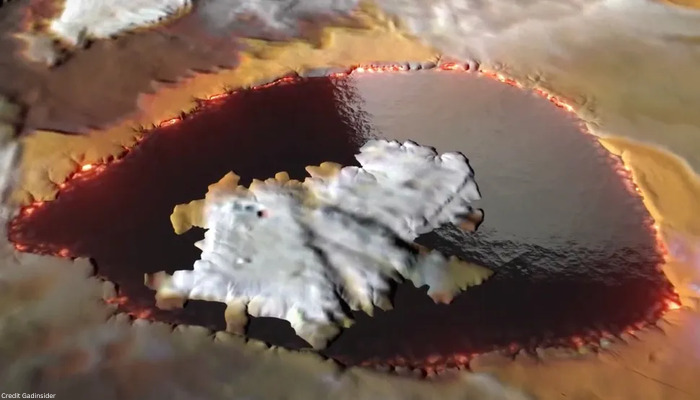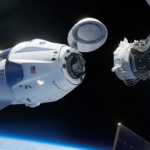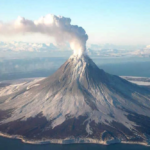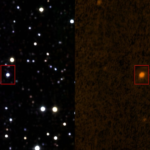Using information from NASA’s Juno spacecraft’s JunoCam imager, this artist’s concept of Loki Patera, a lava lake on Jupiter’s moon Io, was created. Loki is a crater surrounded by molten lava and filled with magma, with several islands nestled within.
NASA/JPL-Caltech/SwRI/MSSS Credit
Data gathered during two recent flybys of Io by scientists on NASA‘s Juno mission to Jupiter has been turned into animations that showcase two of the Jovian moon’s most striking . The solar-powered spacecraft has also recently returned science results on water abundance and Jupiter’s polar cyclones.
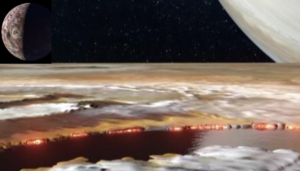
Principal Investigator Scott Bolton of Juno revealed the new discoveries on Wednesday, April 16, at a press conference held in Vienna during the European Geophysical Union General Assembly.
The first up-close photos of the moon’s northern latitudes were captured by Juno during its incredibly close flybys of Io in December 2023 and February 2024, when it approached the moon’s surface by roughly 930 miles (1,500 km).
“We saw a few of the volcanoes in action, and Io is just full of them,” Bolton added. “We also obtained some excellent up-close shots and further information on Loki Patera, a 200-kilometer (127-mile) long lava lake. These bizarre islands are depicted in incredible detail, appearing to be buried in a possible molten lake with a scorching lava rim.
Some areas of Io’s surface appear to be as smooth as glass, resembling the Earth’s obsidian glass, based on the specular reflection our instruments captured of the lake.
During NASA’s Juno spacecraft’s 60th flyby of Jupiter on April 9, the JunoCam instrument recorded this view of Jupiter’s moon Io, featuring the first-ever photograph of its south polar area.
Image courtesy of NASA/JPL-Caltech/SwRI/MSSS. Processing of the image: Thomas Thomopoulos and Gerald Eichstädt (CC BY)
Complete Picture Specifications:
Io’s surface is comparatively smoother than that of Jupiter’s other Galilean moons, and its poles are cooler than middle latitudes, according to maps created using data gathered by Juno’s Microwave Radiometer (MWR) instrument.
Place of the Pole
With every pass throughout its extended mission, Juno’s spacecraft gets closer to Jupiter’s north pole. The MWR instrument’s ability to resolve Jupiter’s northern polar cyclones is enhanced by this shifting orientation. The information enables multiwavelength comparisons of the poles, demonstrating the diversity of polar cyclones.
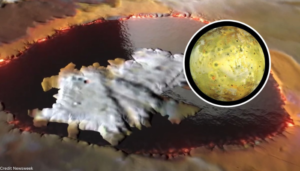
Steve Levin, the project scientist for Juno at NASA’s Jet Propulsion Laboratory in Southern California, stated that the core cyclone at Jupiter’s north pole is “possibly the most striking exampleof this difference.” It is easily visible in both visible and infrared images, even though its microwave signature is not nearly as powerful as that of other nearby storms. This indicates that it has to have a very distinct underlying structure from these other cyclones.
With each orbit, the MWR team records more and better microwave data, so we hope to create a more intricate 3D picture of these fascinating polar storms.
Mercury Water
Gathering information that can aid in a better understanding of Jupiter’s water abundance is one of the mission’s main scientific objectives. Instead than searching for liquid water, the Juno science team is doing this. Rather, its objective is to measure the amount of water-containing molecules, namely oxygen and hydrogen, present in Jupiter’s atmosphere. To solve the enigma of how our solar system formed, a precise estimate is essential.
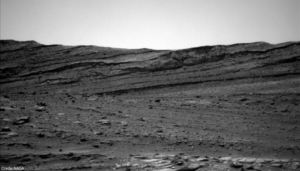
The majority of the gas and dust that did not become part of the Sun is found on Jupiter, which was most likely the first planet to form. The meteorology and internal structure of the gas giant, particularly the movement of wind currents on Jupiter, are significantly impacted by the amount of water present.
A preliminary dataset on Jupiter’s water abundance was released by NASA’s Galileo probe in 1995 during the spacecraft’s 57-minute fall into the Jovian atmosphere. However, the information raised more concerns than it did answers, showing that the gas giant’s atmosphere was surprisingly hot and devoid of water, in contrast to what computer models had predicted.
Read More Articles
In GTA 6 Rockstar’s Opportunity to ‘Steal’ a Stardew Valley Feature Could Be
Crusader Kings 3: Top Legend Seeds, a legitimacy system, and plagues are added.
On your smartphone, Protect Your Privacy by Limiting Calls and Hiding Your IP Address
“The probe performed wonderful research, but we wondered if the area it examined might be an anomaly because its data was so inconsistent with our theories of Jupiter’s water content.
However, we were unable to confirm prior to Juno,” Bolton stated. According to recent studies using MWR data, we have now established that the water abundance at Jupiter’s equator is roughly three to four times the solar abundance in comparison to hydrogen. This unequivocally shows that the arrival point of the Galileo probe was an unusually arid, desert-like area.
The findings lend credence to the theory that water-ice material may have contributed to the heavy element enrichment—the accumulation of chemical components heavier than hydrogen and helium by Jupiter—during the birth and/or development of the gas giant. The creation of Jupiter is still unclear because Juno findings on the gas giant’s core point to a relatively low water abundance.
A puzzle that researchers are still attempting to solve.
Data collected during the remaining portion of Juno’s extended mission could be beneficial since it would allow researchers to compare the water abundance of Jupiter in its polar and equatorial regions and provide more insight into the composition of the planet’s diluted core.
On April 9, during Juno’s most recent flyby of Io, the spacecraft approached the moon’s surface to a distance of roughly 10,250 miles (16,500 km). On May 12, it will make its 61st pass by Jupiter.
